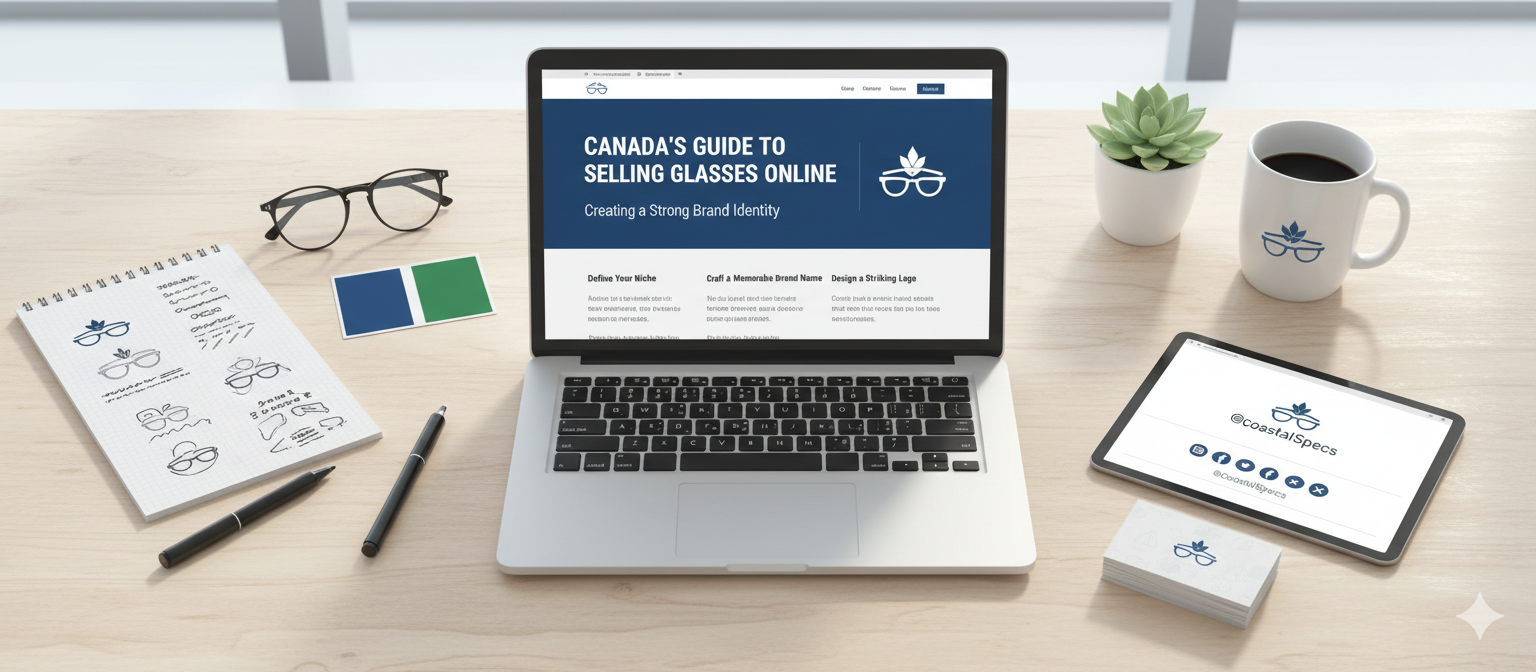
Canada’s Guide to Selling Glasses Online: Finding Frames, Lenses & Reliable Suppliers
Who is this article for?
Two paths, one objective: new e-commerce brands that need a tight, proof-of-concept assortment and existing optical stores adding an online channel with professional oversight. In both cases, you’re looking for suppliers who deliver consistent quality, responsive service, and data that actually fits your storefront and operations.
Your sourcing strategy (before you start calling vendors)
Start by defining your positioning, customer use-cases, and unit economics. If you’re targeting cyclists and runners, you’ll prioritise sport frames, impact-resistant lens materials, mirror/AR coatings, and sweat-resistant nose pads. If you’re going after office and screen use, you’ll emphasise clear AR coatings, blue-light filtration options, and comfort-first fits. This clarity lets you brief suppliers with confidence and keeps early SKUs focused on the 20–40 products most likely to convert.
Next, decide how you’ll fulfil orders: lab-direct, hybrid (you stock frames; lab supplies and finishes lenses), or in-house (lab supplies lenses, you finish in-house). Your model shapes lead times, packaging, and after-sales policies—and it tells suppliers exactly where they fit.
Frames: quality, fit, and brand alignment
Your frame selection communicates your brand before a single word is read. Look for:
- Build quality and materials — Inspect hinge tension and alignment, evenness of temples, bridge geometry, and finish consistency. For metal frames, check plating thickness and solder integrity. For acetates, look for smooth bevels and balanced polishing.
- Fit spectrum and sizes — Aim for a range of eye sizes from 48 to 58. This will cover junior and adjust sizes.
- Supplier readiness — If you are sourcing frames from moverseas, ask for QC standards, batch sampling procedures, and packaging specs. Confirm whether frames ship with cases, cloths, and barcode labels—and whether those can be customised.
- Private label vs. branded — Private label offers control and margin but requires design/QC discipline. Branded frames give you faster credibility but can constrain pricing. Many stores run a mixed strategy: private-label core, plus a small branded capsule for discovery.
- Photography readiness — Require consistent angles (front/45°/side/top), neutral backgrounds, and colour-true images. If vendors can’t provide this, budget for your own photo production so your PDPs stay cohesive.
Lenses: Rx accuracy, coatings, and finishing that scales
Lens quality underpins trust. Customers do not forgive prescription errors or crazing coatings.
- Materials & use-cases — Polycarbonate and Trivex are staples for safety and sport; high-index options keep minus powers thin and comfortable. Offer a simple Good / Better / Best structure for lens bundles so customers can choose quickly.
- Coatings & treatments — Anti-reflective, scratch resistance, hydrophobic/oleophobic top coats, tints, mirrors, and polarization must be described in plain language with “best for” guidance. Insist on coating durability tests and clean warranty terms from your lab.
- Finishing workflow — Decide which steps are done where: surfacing, edging, drilling for rimless and final inspection. A strong finishing partner protects your brand by catching issues before they leave the building.
- Turnaround & remake policy — Publish realistic timelines and set a remake allowance for legitimate Rx issues. Align the policy with your lab’s terms so you’re not stuck absorbing upstream defects.
Why partner with Lens Shapers (reliable lab and ecommerce fulfilment partner)
Lens Shapers is a Canadian wholesale optical lab trusted by independents and online retailers for accurate finishing, quality coatings, custom tints, engraving, and e-commerce fulfilment. If you’re launching online, we help you start lean—edge from inventory you stock or from frames we receive on your behalf, apply coatings/tints to spec, inspect every job against the order, and ship in branded or neutral packaging. If you already run a store, we align with your in-house standards so online orders match the quality your patients expect. The result is consistent Rx accuracy, predictable lead times, and fewer remakes—exactly what a growing e-commerce channel needs.
Vetting suppliers: a practical checklist
Use this short list to keep discovery calls efficient and comparable:
- Quality — Certificates or test data, sampling plan, photo and measurement accuracy, coating durability, and rejection rates.
- Service — Lead times (standard/rush), cut-off times, service coverage (surfacing, tinting, coating, edging, drilling), remake/Warranty terms.
- Data — Clean product data (SKUs, UPC/EAN, frame measurements, colour/variant names), consistent image sets, and pricing files.
- Compliance — Product safety and materials declarations, recalls process, and insurance coverage.
- Logistics — Packaging spec, labelling/barcodes, shipping methods, tracking visibility, and return procedures.
- Commercials — MOQs, price breaks, volume discounts, payment terms, currency, and surcharges (rush, specialty coatings, complex jobs).
Score vendors against your must-haves, then run a paid pilot before you commit. A month of real orders tells you more than a dozen sales calls.
Contracts, SLAs, and the metrics that matter
Put expectations in writing. Define:
- Service-level targets — average/95th-percentile lead times, on-time dispatch percentage, and maximum remake rate.
- Quality gates — Rx tolerance thresholds, coating QC checks, and reinspection after remakes.
- Communication — escalation paths, same-day responses for order-held issues, and proactive alerts for delays.
- Brand handling — packaging requirements, branded/neutral options, insert cards, and serialisation if you use it.
- Data cadence — price file updates, discontinuation notices, and image refresh schedules.
Review performance monthly. If a supplier slips, agree on a corrective plan with a clear timeline.
Inventory strategy: stay lean and in stock
For frames, keep core styles in depth (steady movers that rarely go on promo) and exploration styles in breadth (small buys to test new shapes/colours). For lenses, maintain a view of Rx-type/coating lead times and tag SKUs that extend turnaround so you can communicate accurately at checkout. If you run hybrid or lab-direct models, set minimum stock thresholds on essentials — cases, cleaning cloths etc—to avoid bottleneck.
Data hygiene: what your site (and your lab) needs
Clean data prevents customer confusion and reduces ticket volume:
- Naming consistency — Use a single schema for colours, sizes, and coatings across collections, PDPs, cart, and post-purchase emails.
- Barcodes & SKUs — Assign unique, stable identifiers. Avoid reusing codes across seasons.
- Measurements — Publish lens width/height, bridge, temple, and weight where relevant.
- Imaging — Enforce angle consistency and colour fidelity; avoid mixing render styles with studio shots.
Ask suppliers for a data spec upfront so you don’t spend weeks cleaning spreadsheets.
Packaging and after-sales (where trust compounds)
Standardise on a case, a cleaning cloth, and an insert card that explains fitting tips, care, and warranty in plain language. Add a QR code to a 60-second adjustment video. For returns, document what happens to frames (refurbish, donate, or recycle) and how you process Rx-related remakes vs. preference-based exchanges. Consistency here cuts costs and boosts reviews.
A 30-day sourcing sprint
- Week 1 — Finalise your assortment brief (audience, use-cases, materials, coatings). Shortlist frame vendors and confirm finishing capabilities.
- Week 2 — Request samples, data files, and image packs. Build initial PDPs and check data fit.
- Week 3 — Run a small paid pilot with your lens/finishing partner (e.g., Lens Shapers). Measure accuracy, turnaround, packaging, and support.
- Week 4 — Negotiate terms, sign SLAs, set stock targets, and publish your first 20–40 SKUs. Switch on ads for the top five products and watch early signals.
Bottom line: Great suppliers extend your brand. Choose partners who match your promise on accuracy, speed, and transparency; lock expectations in an SLA; and keep your assortment tight until real data tells you where to grow. If you want a dependable starting point for lenses and finishing, Lens Shapers is set up to help online retailers launch fast—and scale with confidence.
In this Series: Canada’s Guide to Selling Glasses Online
- Canada’s Guide to Selling Glasses Online: Why Now Is the Best Time to Start
- Canada’s Guide to Selling Glasses Online: Building Your Business Plan & Legal Setup
- Canada’s Guide to Selling Glasses Online: Creating a Strong Brand Identity
- Canada’s Guide to Selling Glasses Online: Finding Frames, Lenses & Reliable Suppliers
- Canada’s Guide to Selling Glasses Online: Designing and Launching Your E-Commerce Store
- Canada’s Guide to Selling Glasses Online: Prescription Management & Compliance
- Canada’s Guide to Selling Glasses Online: Packaging, Shipping & Returns
- Canada’s Guide to Selling Glasses Online: Pricing for Profit and Growth
- Canada’s Guide to Selling Glasses Online: Marketing to Get Your First 100 Customers
- Canada’s Guide to Selling Glasses Online: Using Virtual Try-On & Tech Tools to Build Trust
- Canada’s Guide to Selling Glasses Online: Scaling and Automating Your Business
- Canada’s Guide to Selling Glasses Online: Trends & Future Opportunities





